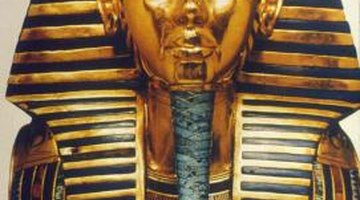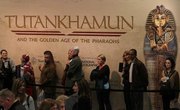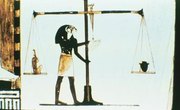In 1922, after years of searching, British Egyptologist Howard Carter made the historically important discovery of a virtually intact pharaoh's tomb. It was thought that over the centuries all the tombs in the Valley of Kings had been plundered by robbers. Carter believed that the tomb of the young King Tutankhamen still lay undiscovered. While the discovery yielded many valuable items, including the sarcophagus of Tutankhamen himself, the tomb had not gone undiscovered. It had been robbed at least twice over the centuries.
The First Robbery
It is speculated that the first robbery of Tutankhamen's tomb occurred within a few years of his burial. This is evidenced by the types of items the robbers took: oils, perfumes and cosmetics, all of which had a limited shelf life. If they had been stolen more than a few years after the burial, they would have been worthless because the ingredients would have spoiled. It is thought that these first robbers also stole metal adornments and fixtures from the tomb walls. When the robbery was discovered, the priests in charge of protecting the tombs resealed the entrance holes.
The Second Robbery
The second set of robbers likely arrived soon after the first set and had a much larger haul than the first robbers, though they mainly looted the antechamber -- the first room they came to at the end of the entrance passage. Based on the discovered tomb inventory, it is assumed the robbers stole over half the jewels and many precious-metals containers. It is thought that they spent hours tunneling and passing baskets of treasure along the passageway, and because of the lengthy operation they were caught or interrupted, which is why they left the rooms past the antechamber undisturbed. The tomb was once again resealed, and it remained sealed until being discovered by Howard Carter.
Why Wasn't the Tomb Looted Again?
The tomb of Tutankhamen may have been built for a rich businessman rather than the king. Tutankhamen died suddenly at a young age, and priests may have had to scramble to find him a proper tomb, using one that was already available and refitting it for Tutankhamen. This may have made it lower profile and less prone to discovery. The tomb was also located between and beneath two much more visible tombs -- those of Ramses II and Ramses IV. Robbers may have concentrated their efforts on those tombs and overlooked the much smaller, more inconspicuous tomb entrance of Tutankhamen.
How Did Carter Find It?
Howard Carter spent many years searching for the tomb of Tutankhamen. He felt that the tomb must be in the Valley of the Kings. Financed by the Lord Carnarvon of England, Carter dug in several locations he thought may hold the tomb. While excavating around the tomb of Ramses IV, Carter had about 10 feet of rubble removed from the area containing the stone huts of ancient workmen. Beneath one of the newly uncovered huts he found the staircase leading to the sunken entrance of Tutankhamen's tomb.
Related Articles
References
Writer Bio
Jill Kokemuller has been writing since 2010, with work published in the "Daily Gate City." She spent six years working in a private boarding school, where her focus was English, algebra and geometry. Kokemuller is an authorized substitute teacher and holds a Bachelor of Arts in English from the University of Iowa.











